2021 年 90 巻 2 号 p. 161-171
2021 年 90 巻 2 号 p. 161-171
Low-potassium crops are required for patients with kidney disease, and research on the production of low-potassium vegetables using hydroponics has been conducted. However, there are few studies on low-potassium fruit trees because the soil is generally cultivated. This study focused on blueberries that can be cultivated in a pot, by examining the production of low-potassium blueberry fruits cultured with fertigation in a greenhouse. In a pot culture using peat moss medium, the potassium levels were restricted from the flowering stage and from the fruit coloring stage, causing a decrease in the potassium content of the fruits by 53 and 35%, respectively, when compared with the control. A urethane sponge-based medium with free nutrient leaching was then evaluated to determine whether the potassium content of fruits decreased with short-term potassium restriction. The results showed a reduction in potassium content of 48% when potassium was restricted in the fruit coloring period. In addition, potassium was restricted for five months to determine whether long-term potassium restriction could further reduce the potassium content of fruits. The fruit potassium content did not differ between the second and fifth months after the potassium restriction, although symptoms of potassium deficiency appeared in mature leaves. From these results, it was suggested that the pot culture with fertigation was effective in producing low-potassium blueberry fruits, and the fruit potassium content can be halved by short-term potassium restriction using the urethane sponge-based medium. However, long-term potassium restriction was not effective in producing low-potassium blueberry fruits due to the appearance of symptoms of potassium deficiency.
The major causes of kidney failure are diabetes and hypertension in both developed and developing countries (Jha et al., 2013). Declining kidney function increases the risk of cardiovascular mortality (Wang and Lai, 2006; Jha et al., 2013). In 2018, heart failure was the most common cause of death in kidney disease patients in Japan (Nitta et al., 2019). Malfunctioning kidneys cannot properly excrete potassium ingested from foods, which may further deteriorate the kidney function; therefore, patients with kidney failure undergo dialysis to excrete excess potassium. Even though the cost of receiving dialysis is high (Jha et al., 2013; Levin et al., 2017), the number of chronic dialysis patients had increased to 339 841 at the end of 2018 in Japan (Nitta et al., 2019). As kidney failure reaches the progressive stage, intake restrictions of potassium, protein, and other nutrients is highly recommended (Iseki and Yamagata, 2016). The intake of potassium is ideally less than 1500 mg·day−1, and this level can be reached by the ingestion of a moderate amount of spinach (Spinacia oleracea) or half a melon (Cucumis melo). Therefore, low-potassium food crops, especially vegetables and fruits, are needed for patients with kidney failure.
Currently, low-potassium vegetables, which facilitate the nutritional management of dialysis patients, are produced by restricting potassium fertilization in hydroponically grown leaf vegetables. By suspending potassium fertilization from 22 days after seeding in spinach, and 22 days after transplant in red leaf lettuce (Lactuca sativa var. crispa) (Ogawa et al., 2007, 2012), or supplying 25% potassium for 25 days in romaine lettuce (Lactuca sativa var. longifolia) (Zhang et al., 2017), the leaf potassium content was reduced in all species by 72 to 90%. The potassium content of fruit vegetables has also been successfully lowered. For example, the potassium level was limited after the first fruit set in tomato (Solanum lycopersicum) (Ogawa et al., 2012), after pollination in melon (potassium reduced to 25% of the standard) (Asao et al., 2013), and after the first anthesis in strawberry (Fragaria × ananassa) (potassium reduced to 6.5% of the standard) (Mondal et al., 2017), and these reductions caused the fruit potassium content to be lowered by between 39 and 64% of that of normal fruits.
In contrast to leaf and fruit vegetables, few studies have been conducted on producing low-potassium fruits in fruit trees (Shen et al., 2017). Unlike hydroponics used for vegetable production, fruit trees are usually grown in the soil, which makes it difficult to control the uptake of water and nutrients. Although hydroponic cultivation of fruit trees has not been established to date, there are some fruit trees that are grown in pots and fed with a nutrient solution (Hata et al., 2008; Xie et al., 2009; Asano et al., 2013), including blueberry (Higashide et al., 2006; Li and Bi, 2019; Clark and Zheng, 2020). To avoid the disadvantage of using the soil to control potassium uptake by plants, culturing in pots may be an alternative. Ikeura et al. (2012) observed that potted soil culture caused nutrient shortage more easily compared with an open field in zucchini (Cucurbita pepo), likely due to the weak ability of the soil to buffer the modified nutrient supply. Potted soil cultures, which restrict both the amount of soil and expansion of the root system, may have the potential to produce low-potassium fruit when combined with fertigation. In addition, a fertilizing solution, rather than a solid fertilizer, is recommended for commercial blueberry fruit production (Piller et al., 2003).
In order to further control the potassium uptake in potted cultures, replacing the soil with an artificial medium that has a low fertilizer retention capacity may be beneficial. Blueberry trees were grown in pots with natural growing media such as peat moss or coir, and with artificial media including rock wool and urethane sponge-based ‘Pafcal’ (Toyota Suntory Midorie (Shanghai) Co., Ltd., Shanghai, China). Blueberry trees grew well in all planting media with fertigation, but the leaves grown on ‘Pafcal’ turned yellow, showing a sign of nutrient shortage, soon after the nutrient fertigation was replaced by tap water irrigation. ‘Pafcal’ therefore was considered to have a low fertilizer retention capacity.
Controlling the potassium accumulation of blueberry trees grown in pots requires fertigation and a medium with high nutrient-leaching characteristics. To establish the production of low-potassium blueberry fruits, we: 1) investigated the effect of potassium restriction during different developmental stages, and for different lengths of time on the fruit potassium content in the potted blueberry; 2) evaluated the use of a urethane sponge-based medium that easily leaches nutrients for the production of low-potassium blueberry fruits; and 3) tested whether extended potassium restriction using the urethane sponge-based medium can further reduce the fruit potassium content.
Four-year-old southern highbush blueberry ‘Sharpblue’ trees were used. The potted blueberry trees were fertigated with either 50% Enshi nutrient solution (Hori, 1966) or a potassium-restricted nutrient solution in which the potassium concentration had been reduced to zero by replacing potassium nitrate with nitric acid. Each nutrient solution was adjusted to a pH of 5.0 ± 0.5, and an electrical conductivity (EC) of 1.00 ± 0.10 mS/cm. To adjust the pH of each nutrient solution, 500 mL of 60 × diluted PH Adjuster Down (OAT Agrio Co., Ltd., Tokyo, Japan) was added to 50 L of the 50% Enshi nutrient solution, and 200 mL of 3% sodium hydroxide was added to 50 L of the potassium-restricted nutrient solution.
2. Experiment 1: Effects of potassium restriction on the potassium content in fruits 1) Cultivation of plant materialsOn April 10, 2015, 30 blueberry trees were transplanted in 4-L pots with the mixed substrates of peat moss and kanuma-tsuchi at a 1:1 ratio as the growing medium. Kanuma-tsuchi is a volcanic pumice found in Kanuma City, Tochigi, Japan, which has good water retention and aeration properties (Yabashi et al., 1994). These potted trees were cultivated in a greenhouse and irrigated with tap water until the beginning of Experiment 1. On May 1, blueberry trees at the same growth level were carefully selected. Due to the limited cultivation area suitable for keeping plants under similar conditions in our experimental facilities, and the indeterminate level of plant growth of blueberry trees, only 18 trees were set up for the experiment.
2) Experimental designFigure 1 illustrates the design of Experiment 1. Three treatments and three analysis stages were arranged. The first treatment was the control, which was fertigated with the 50% Enshi nutrient solution. The second treatment was fertigation with the potassium-restricted nutrient solution for 35 days (five weeks) from the fruit coloring stage. The third treatment was fertigation with the potassium-restricted nutrient solution for 71 days (ten weeks) from the flowering stage. The three stages of analysis were the flowering stage, fruit coloring stage, and harvesting stage.

Experimental design and sampling schedule in Experiment 1.  : fertigated with potassium,
: fertigated with potassium,  : fertigated without potassium (potassium restriction treatment), ▽: sampling (3 plants dried for analysis). Potassium restriction treatment lasted for five weeks from the fruit coloring stage and lasted for ten weeks from the flowering stage.
: fertigated without potassium (potassium restriction treatment), ▽: sampling (3 plants dried for analysis). Potassium restriction treatment lasted for five weeks from the fruit coloring stage and lasted for ten weeks from the flowering stage.
First, at the flowering stage on May 2, when blueberries started flowering and fruiting, three trees were separated into four parts (roots, stems, leaves, and fruit), dried at 80°C for 96 h, and then weighed. On May 6, the remaining 15 potted blueberries were divided into two groups: nine trees with and six trees without potassium fertigation. Second, at the fruit coloring stage on June 10, three out of the nine trees with potassium fertigation were separated into the four parts and dried for analysis. Three out of the six trees without potassium fertigation were also separated into the four parts and dried for analysis. Third, at the harvesting stage on July 15, three trees from each treatment were separated into the four parts and dried for analysis. All harvested fruits (20 to 25 fruits) from each tree were stored in a freezer at −80°C after the mean fruit weight was calculated, and then 10 fruits from each tree were freeze-dried.
Dried samples from the three stages of three treatments were digested in a fume hood with nitric acid by heat: 80°C for 20 min, 90°C for 10 min, 120°C for 10 min, 130°C for 10 min, and 140°C for 10 min. Perchloric acid was then added and the samples were heated again at 140°C for 10 min, 160°C for 10 min, 170°C for 10 min, and 180°C for 10 min. After the samples were clarified, they were cooled, filtered, and diluted with water. The potassium content was measured by flame photometry, and calcium and magnesium contents by atomic absorption spectrometry, using the Soil and Plant Clinical Analyzer (SPCA-6210; Shimadzu Corporation, Kyoto, Japan). The fresh fruit content at the harvesting stage was calculated in accordance with the moisture ratio, based on the fresh and dry weights.
Soluble sugar content and titratable acidity were determined from fruits of the harvesting stage stored in a freezer at −80°C. Fruit pulp (5 mm3) was homogenized with distilled water and centrifuged at 13000 rpm for 10 min. The soluble sugar content in the supernatant was measured with a digital refractometer (PR-101α; Atago Co., Ltd., Tokyo, Japan). Titratable acidity was estimated based on the citric acid content by adding distilled water and phenolphthalein solution to the supernatant and performing neutralization titration with 0.1 N sodium hydroxide.
3. Experiment 2: Effects of short-term potassium restriction using the urethane sponge-based medium 1) Cultivation of plant materialsOn May 13, 2016, the root balls of a 4-year-old blueberry tree were trimmed to approximately 10 cm in diameter with a saw. The trees were then transplanted into 4-L pots filled with the urethane sponge-based medium ‘Pafcal’ (Toyota Suntory Midorie (Shanghai)). The pot medium was made of a mixture of urethane and water-dispersing material (Pafcal; Toyota Suntory Midorie (Shanghai)), ensuring root aeration and an even distribution of water across the medium. Thus, easier leaching of nutrients was expected in the urethane sponge-based medium compared with natural planting materials. The potted trees were cultivated both in an open field and a greenhouse through May 30, 2017, and then moved to a controlled environment room with a low-temperature (12°C) under short-day conditions (8 h) to trigger flower bud differentiation, according to the forcing culture protocol for blueberry (Ogiwara et al., 2012; Aung et al., 2014; Cho et al., 2017). On August 1, the trees bearing flower buds were transferred to a greenhouse for advanced flowering. Fertigation during this cultivation was applied with the 50% Enshi nutrient solution. On October 7, ten trees with the same growth level were carefully chosen and the nutrients that accumulated in the pots were leached with water until the EC of the drainage was equivalent to tap water.
2) Experimental designFigure 2 illustrates the design of Experiment 2. Two treatments were arranged at the fruit coloring stage on October 8 by dividing ten trees into two groups: five trees fertigated with the 50% Enshi nutrient solution for the control; and another five trees fertigated with the potassium-restricted nutrient solution; for approximately five weeks. At the harvesting stage from October 17 through November 28, fruits were harvested to measure the potassium content, mean fruit weight, soluble sugar content, and titratable acidity. At the end of the harvesting stage on November 28, approximately 2 g of leaves were collected to determine the levels of potassium, calcium, and magnesium. All fruits and leaves collected for analysis were dried at 80°C for 96 h, and then analyzed in the same manner as in Experiment 1.

Experimental design and sampling schedule in Experiment 2.  : fertigated with potassium,
: fertigated with potassium,  : fertigated without potassium (potassium restriction treatment), ▽: sampling (leaves and fruits dried for analysis). Potassium restriction treatment lasted for five weeks from the fruit coloring stage.
: fertigated without potassium (potassium restriction treatment), ▽: sampling (leaves and fruits dried for analysis). Potassium restriction treatment lasted for five weeks from the fruit coloring stage.
Blueberry trees were transplanted on May 13, 2016, as described in Experiment 2. The transplanted trees were placed in an open field until September 21, and then moved to a controlled environment room at a low-temperature (12°C) under short-day conditions (8 h) for triggering flower bud differentiation, according to the forcing culture protocol for blueberry (Ogiwara et al., 2012; Aung et al., 2014; Cho et al., 2017). On November 18, the trees bearing flower buds were transferred to a greenhouse at a temperature of 8°C or higher for advanced flowering. Fertigation in this cultivation was based on the 50% Enshi nutrient solution. On February 21, 2017, four trees with the same growth level were carefully selected.
2) Experimental designFigure 3 illustrates the design of Experiment 3. From the end of the flowering stage on February 22, four trees were fertigated with the potassium-restricted nutrient solution for five months. Every month, photographs of the blueberry trees were taken, and approximately 3 g of new leaves were collected to determine the potassium, calcium, and magnesium content. Fruits were harvested from the second to fifth months to measure the potassium content, mean fruit weight, soluble sugar content, and titratable acidity. With the continuous-blooming technique (Ogiwara et al., 2012), the harvesting stage of blueberry lasted for four months. All fruits and leaves collected for analysis were dried at 80°C for 96 h, and then analyzed in the same manner as in Experiment 1.

Experimental design and sampling schedule in Experiment 3.  : fertigated without potassium (potassium restriction treatment), ▼: sampling (leaves dried for analysis), ▽: sampling (leaves and fruits dried for analysis). Potassium restriction treatment lasted for five months and fruits were harvested for four months from second through fifth months.
: fertigated without potassium (potassium restriction treatment), ▼: sampling (leaves dried for analysis), ▽: sampling (leaves and fruits dried for analysis). Potassium restriction treatment lasted for five months and fruits were harvested for four months from second through fifth months.
Statistical analysis was carried out using BellCurve for Excel. In Experiment 1, the dry weight, content of three essential nutrients, and fruit quality were analyzed by the t-test or Tukey’s test, in order to compare the two different degrees of potassium restriction with the control. In Experiment 2, the fruit potassium content, fruit quality, and content of the three nutrients in leaves were analyzed by the t-test, in order to compare the potassium-restricted treatment with the control. In Experiment 3, the fruit potassium content, fruit quality, and content of the three nutrients in new leaves were analyzed by Fisher’s LSD to compare the outcomes of each month during the five-month restriction.
In the two potassium-restricted treatments of blueberry beginning in the different stages of fruit production, the potassium content of harvested fruits was significantly lower than that of the control (Fig. 4). While the ten-week potassium restriction in the flowering stage led to a 53% reduction in the fruit potassium content, the five-week restriction in the fruit coloring stage reduced it by 35%. However, there were no significant differences among the three treatments regarding the mean fruit weight, soluble sugar content, and titratable acidity (Table 1).
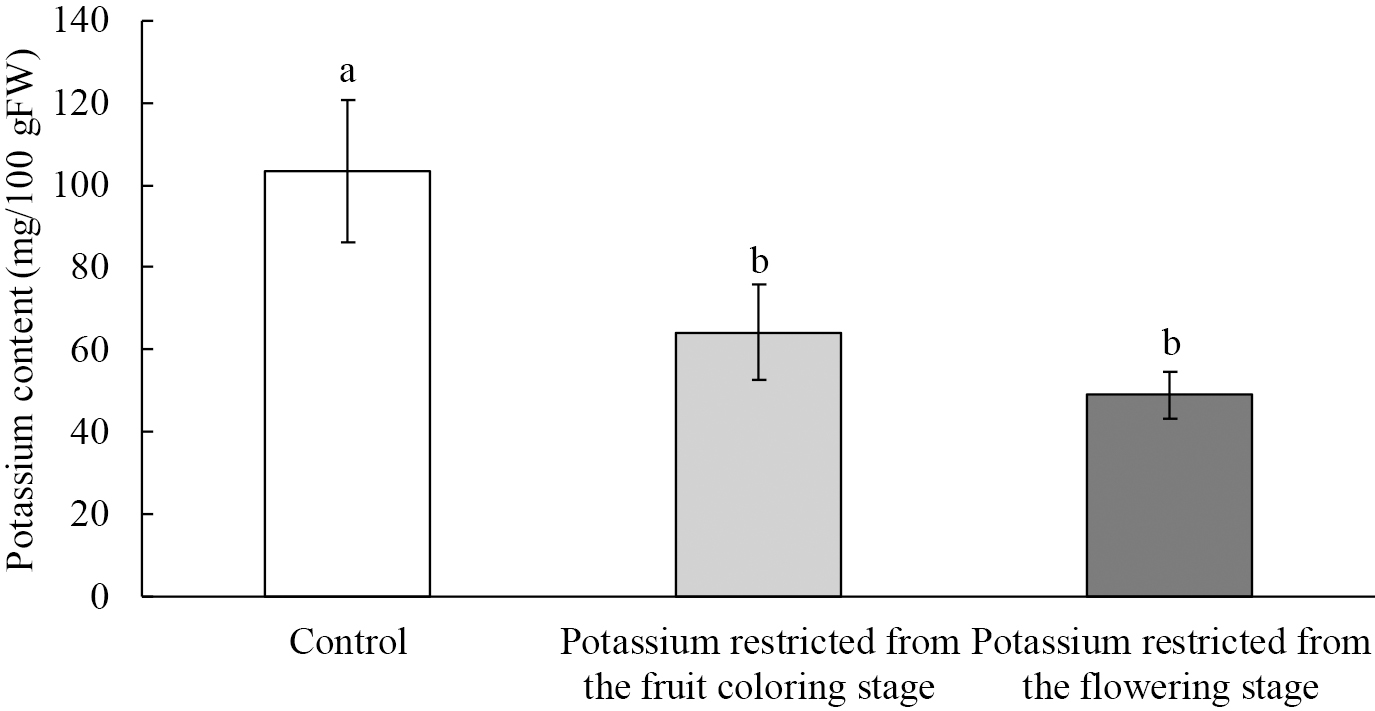
Effects of potassium restriction treatments from two development stages of potted blueberry trees on the fruit potassium content at the harvesting stage in Experiment 1. Potassium restriction treatment lasted for five weeks from the fruit coloring stage and lasted for ten weeks from the flowering stage. Different small letters denote a significant difference at P < 0.05 by Tukey’s test (n = 3), and the vertical bars indicate standard deviation (SD).

Effects of potassium restriction treatments from two development stages of potted blueberry trees on mean fruit weight, soluble sugar content, and titratable acidity of fruits at the harvesting stage in Experiment 1.
Dry weights of the total tree and four separate parts at the harvesting stage were greater than at the flowering stage, while comparisons within the harvesting stage revealed that there were no significant differences among the three treatments (Fig. 5). However, the longer potassium restriction time led to a lower potassium content in the trees, meaning restriction at the flowering stage led to a lower potassium content than at the fruit coloring stage (Fig. 6). The decreases in the potassium content in the dried tree parts treated with potassium restriction from the flowering stage were: 76% for leaves, 62% for roots, 53% for stems, and 40% for fruits, compared with the control.
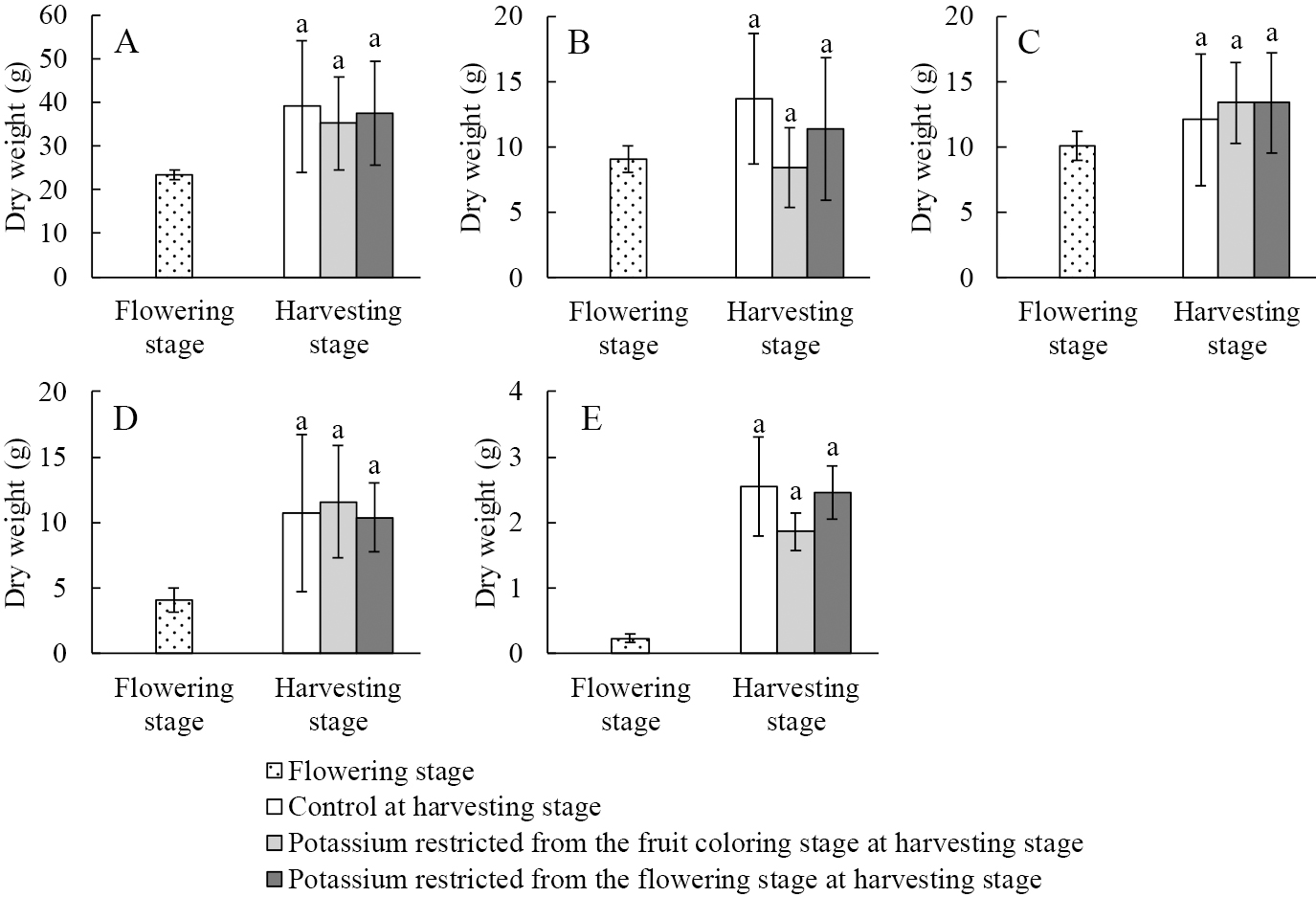
Effects of potassium restriction treatments from two development stages of potted blueberry trees on dry weight of trees (A = B + C + D + E), roots (B), stems (C), leaves (D), and fruits (E) at the flowering and harvesting stages in Experiment 1. Potassium restriction treatment lasted for five weeks from the fruit coloring stage and lasted for ten weeks from the flowering stage. Ten fruits were used for measuring dry weight of fruits. Same small letters at the harvesting stage denote a non-significant difference at P < 0.05 by Tukey’s test (n = 3), and the vertical bars indicate SD.
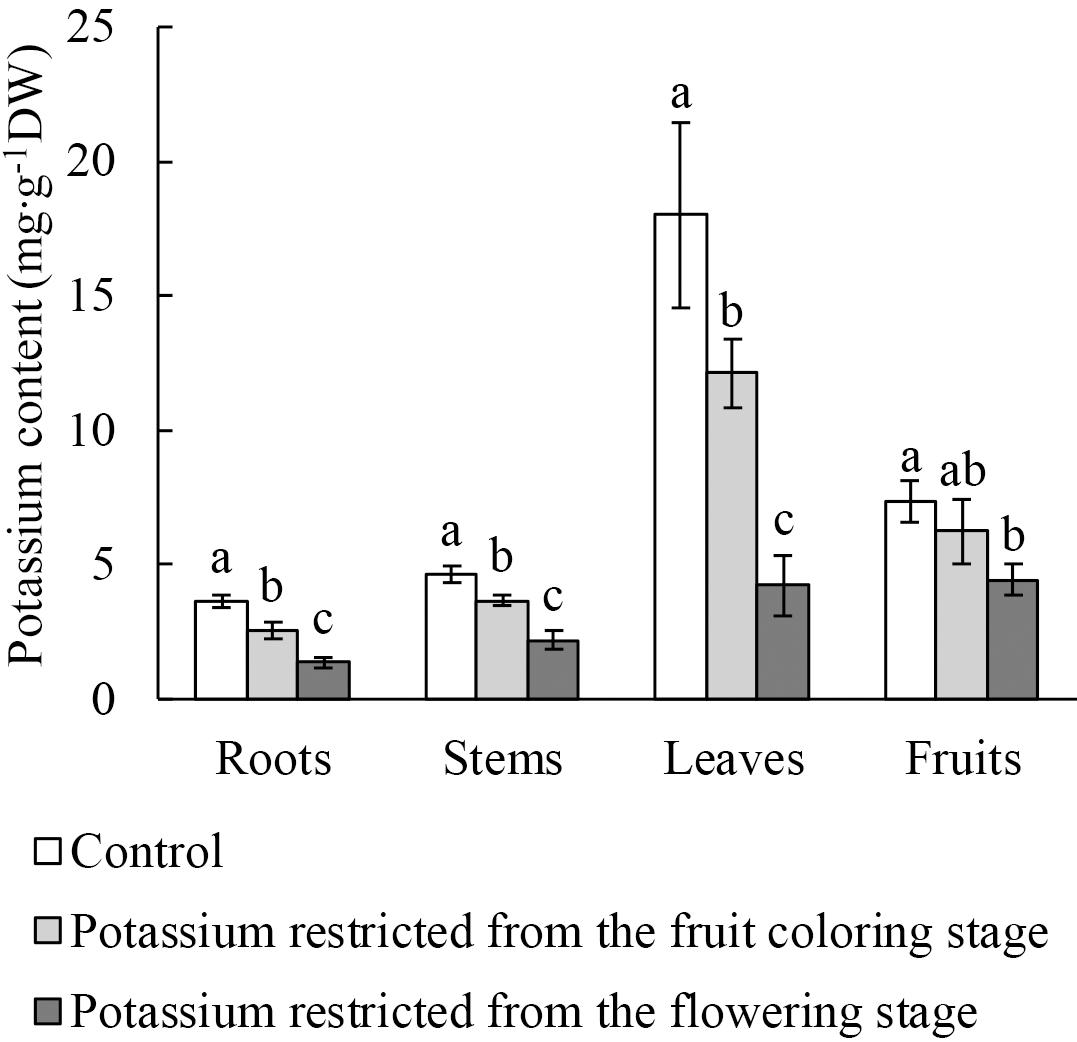
Effects of potassium restriction treatments from two development stages of potted blueberry trees on the potassium content in roots, stems, leaves, and fruits at the harvesting stage in Experiment 1. Potassium restriction treatment lasted for five weeks from the fruit coloring stage and lasted for ten weeks from the flowering stage. Different small letters denote a significant difference at P < 0.05 by Tukey’s test (n = 3), and the vertical bars indicate SD.
Changes in the potassium content of the total blueberry tree that underwent potassium restriction in the different stages are shown in Figure 7. The effects of potassium restriction appeared immediately after the restriction treatment started in the two potassium-restricted treatments, while the potassium content of the control trees with potassium fertigation increased from the flowering to harvesting stages. At the fruit coloring stage, the potassium content of trees in which restriction began at the flowering stage was lower than that of the control. At the harvesting stage, the potassium content was significantly lower with the two potassium-restricted treatments compared with the control.

Transition of the potassium content in potted blueberry trees (total of roots, stems, leaves, and fruits) throughout the stages of flowering, fruit coloring, and harvesting in Experiment 1. Potassium restriction treatment lasted for five weeks from the fruit coloring stage and lasted for ten weeks from the flowering stage. ** at the fruit coloring stage stands for significant difference at P < 0.01 by t-test (n = 3), different small letters at harvesting stage denote a significant difference at P < 0.05 by Tukey’s test (n = 3), and the vertical bars indicate SD.
The content of calcium and magnesium of most blueberry parts showed no significant differences by potassium restriction treatment (Fig. 8), but the calcium content in leaves on treatment starting in the flowering stage was almost double that of the control (Fig. 8A).
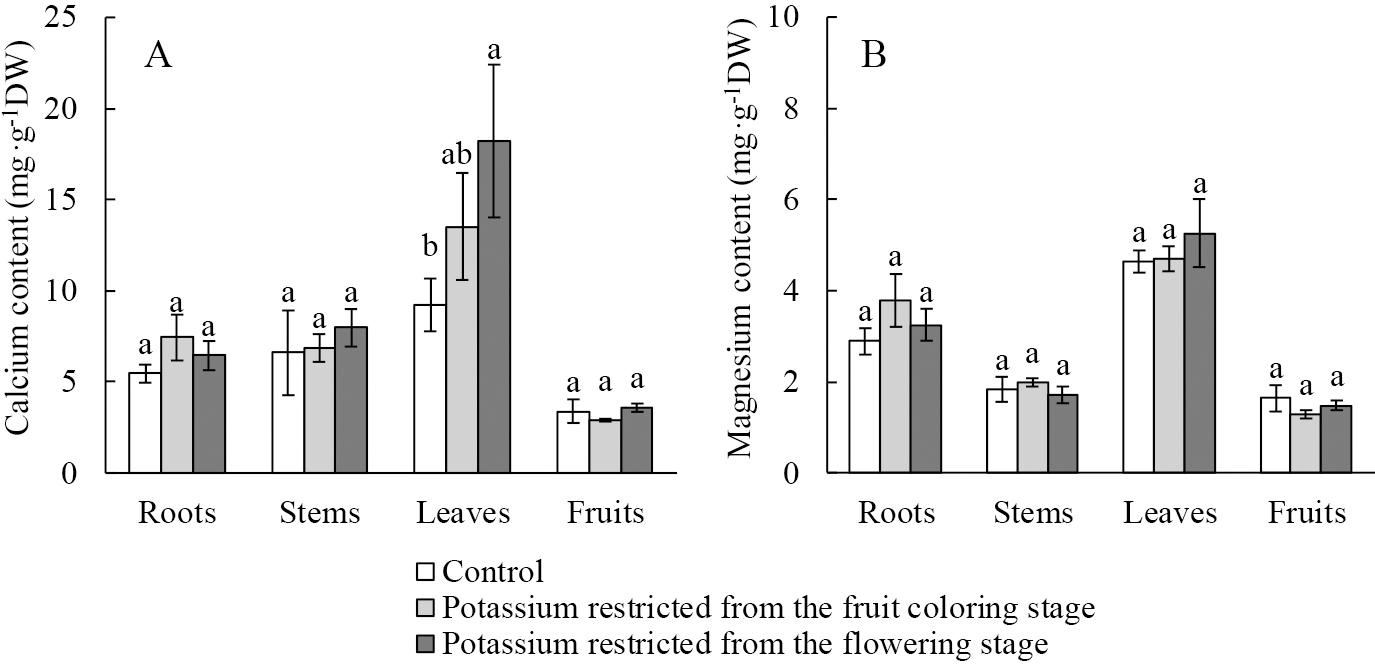
Effects of potassium restriction treatments from two development stages of potted blueberry trees on the content of calcium (A) and magnesium (B) in roots, stems, leaves, and fruits at the harvesting stage in Experiment 1. Potassium restriction treatment lasted for five weeks from the fruit coloring stage and lasted for ten weeks from the flowering stage. Different small letters denote a significant difference at P < 0.05 by Tukey’s test (n = 3), and the vertical bars indicate SD.
The potassium content in blueberry trees that underwent the potassium restriction treatment for approximately five weeks was significantly lower than that of the control, with a reduction rate of 48% (Fig. 9). The mean fruit weight, soluble sugar content, and titratable acidity in fruits with potassium restriction did not show significant differences compared with the control (Table 2).

Effects of the short-term potassium restriction of blueberry trees potted with the urethane sponge-based medium on the fruit potassium content at the harvesting stage in Experiment 2. Potassium restriction treatment lasted for five weeks from the fruit coloring stage. ** denotes a significant difference at P < 0.01 by t-test (n = 5), and the vertical bars indicate SD.

Effects of the short-term potassium restriction on blueberry trees potted with the urethane sponge-based medium on mean fruit weight, soluble sugar content, and titratable acidity of fruits at the harvesting stage in Experiment 2.
The potassium content in the leaves of blueberry trees with potassium restriction treatment was significantly lower than that of the control (Fig. 10A). Conversely, the content of calcium in leaves with potassium restriction treatment was significantly higher than that of the control (Fig. 10B), whereas the magnesium content did not differ significantly (Fig. 10C).

Effects of the short-term potassium restriction of blueberry trees potted with the urethane sponge-based medium on the content of potassium (A), calcium (B), and magnesium (C) in leaves at the harvesting stage in Experiment 2. Potassium restriction treatment lasted for five weeks from the fruit coloring stage. ** denotes a significant difference at P < 0.01 by t-test (n = 5), NS stands for non-significant difference at P < 0.05 by t-test (n = 5), and the vertical bars indicate SD.
Symptoms of potassium deficiency such as leaf scorching and curling at the edges (Fig. 11D) appeared on mature blueberry leaves in the third month after the potassium restriction treatment began (Fig. 11B). Such symptoms were widespread on the trees in the fifth month after the potassium restriction treatment began (Fig. 11C).
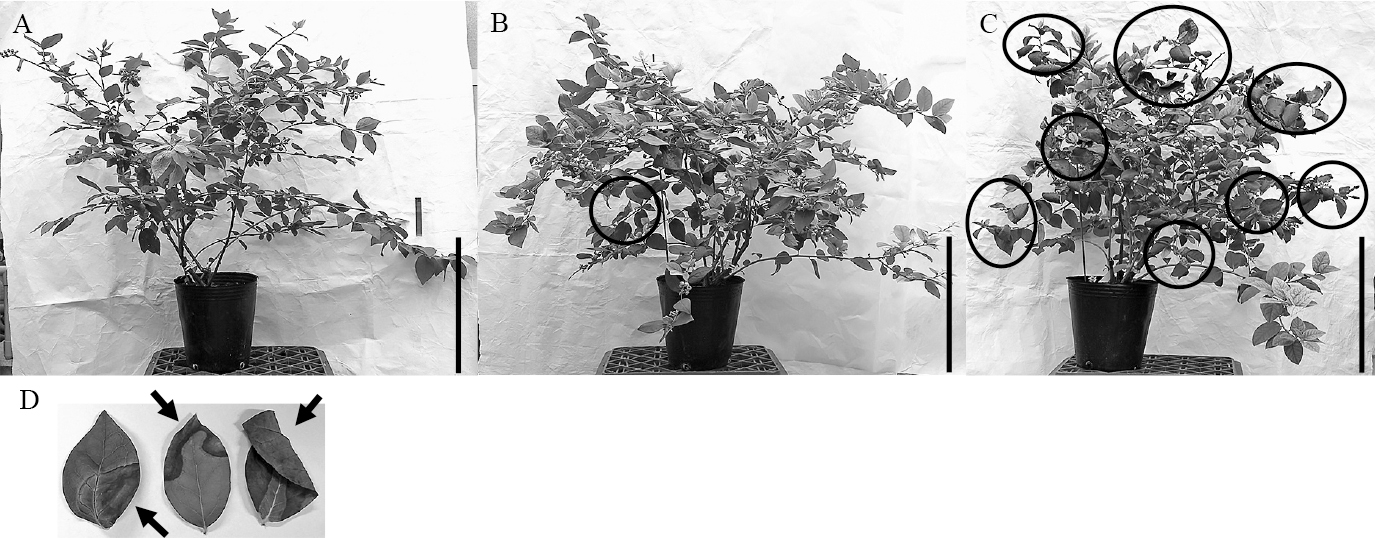
Effects of the long-term potassium restriction of blueberry trees potted with the urethane sponge-based medium on the morphological changes of the studied blueberry in Experiment 3. A: the original shape before potassium restriction started, B: appearance in the third month of potassium restriction with visual symptoms of deficiency in leaves, as indicated by a circle, C: appearance in the fifth month of potassium restriction with visual symptoms of deficiency in leaves, as indicated by circles, D: leaves with symptoms of potassium deficiency as indicated by arrows. The black bars in the bottom right of A, B, and C indicate 30 cm in length. Potassium restriction treatment lasted for five months.
The potassium content and titratable acidity in fruits did not significantly differ among the five months of potassium restriction (Fig. 12; Table 3). The mean fruit weight in the second month was significantly higher than that in the other three months, while the value in the third month was not significantly different from those in the fourth and fifth months, but that in the fifth month was significantly lower than in the fourth month (Table 3). The soluble sugar content in the second month was significantly higher than in the third and fifth months, but the values in the third through fifth months were not significantly different (Table 3).
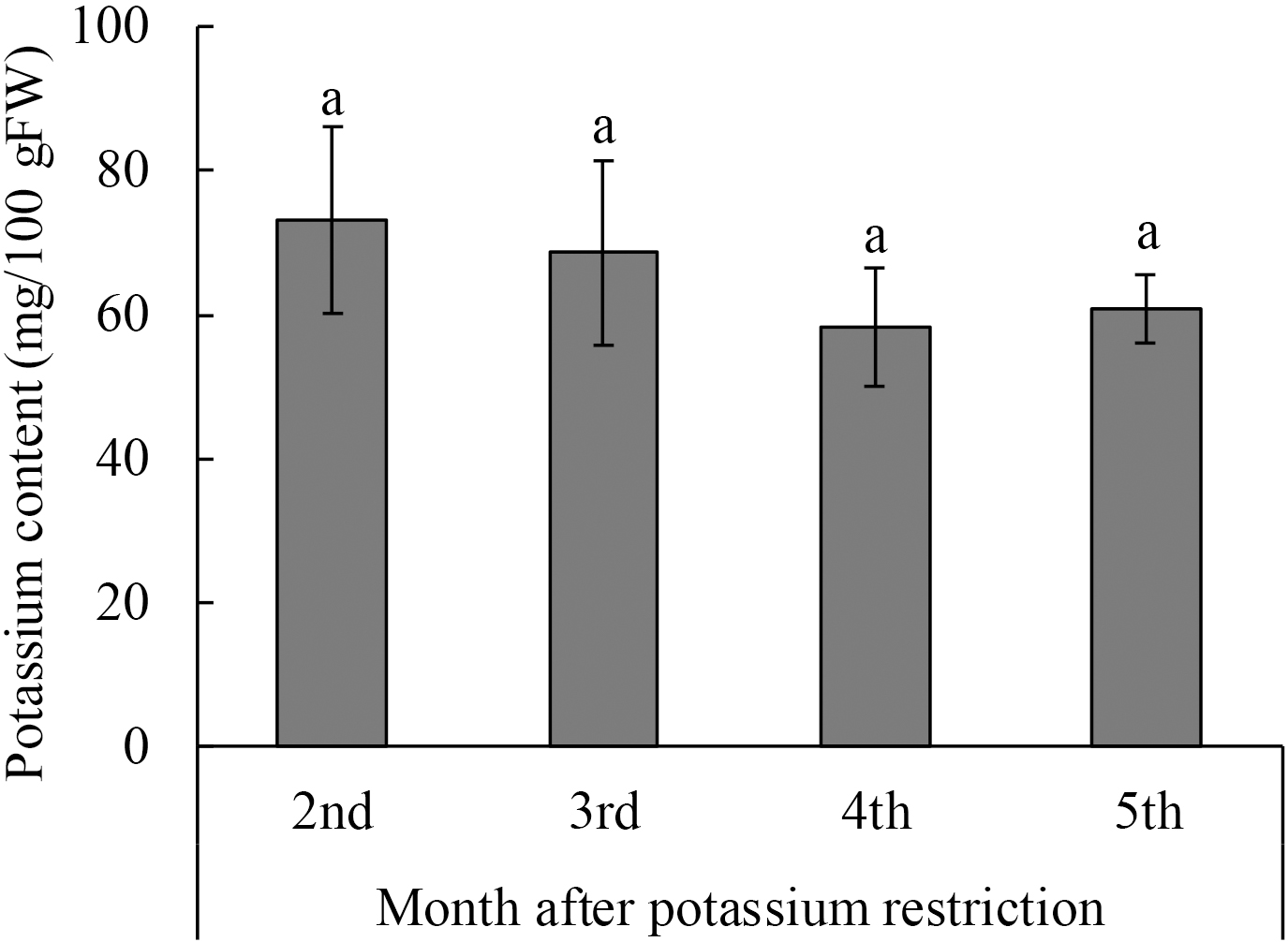
Effects of the long-term potassium restriction of blueberry trees potted with the urethane sponge-based medium on the monthly fruit potassium content in Experiment 3. Potassium restriction treatment lasted for five months and fruits were harvested for four months from second through fifth months. The same small letters denote a non-significant difference at P < 0.05 by Fisher’s LSD test (n = 4), and the vertical bars indicate SD.

Effects of the long-term potassium restriction on blueberry trees potted with the urethane sponge-based medium on mean fruit weight, soluble sugar content, and titratable acidity of fruits at the harvesting stage in Experiment 3.
The potassium content in new leaves was significantly lower in the third and fourth months after potassium restriction than before restriction treatment, while the fourth month showed the lowest potassium content (Fig. 13A). Conversely, the calcium content in new leaves was significantly higher from the second to fifth months than before the restriction treatment, and that in the fourth month was significantly higher than in the third month, but lower than in the fifth month (Fig. 13B). In addition, the magnesium contents in new leaves were significantly higher from the second to fifth months than before the restriction treatment, and those in the fourth and fifth months were significantly higher than in the other months (Fig. 13C).
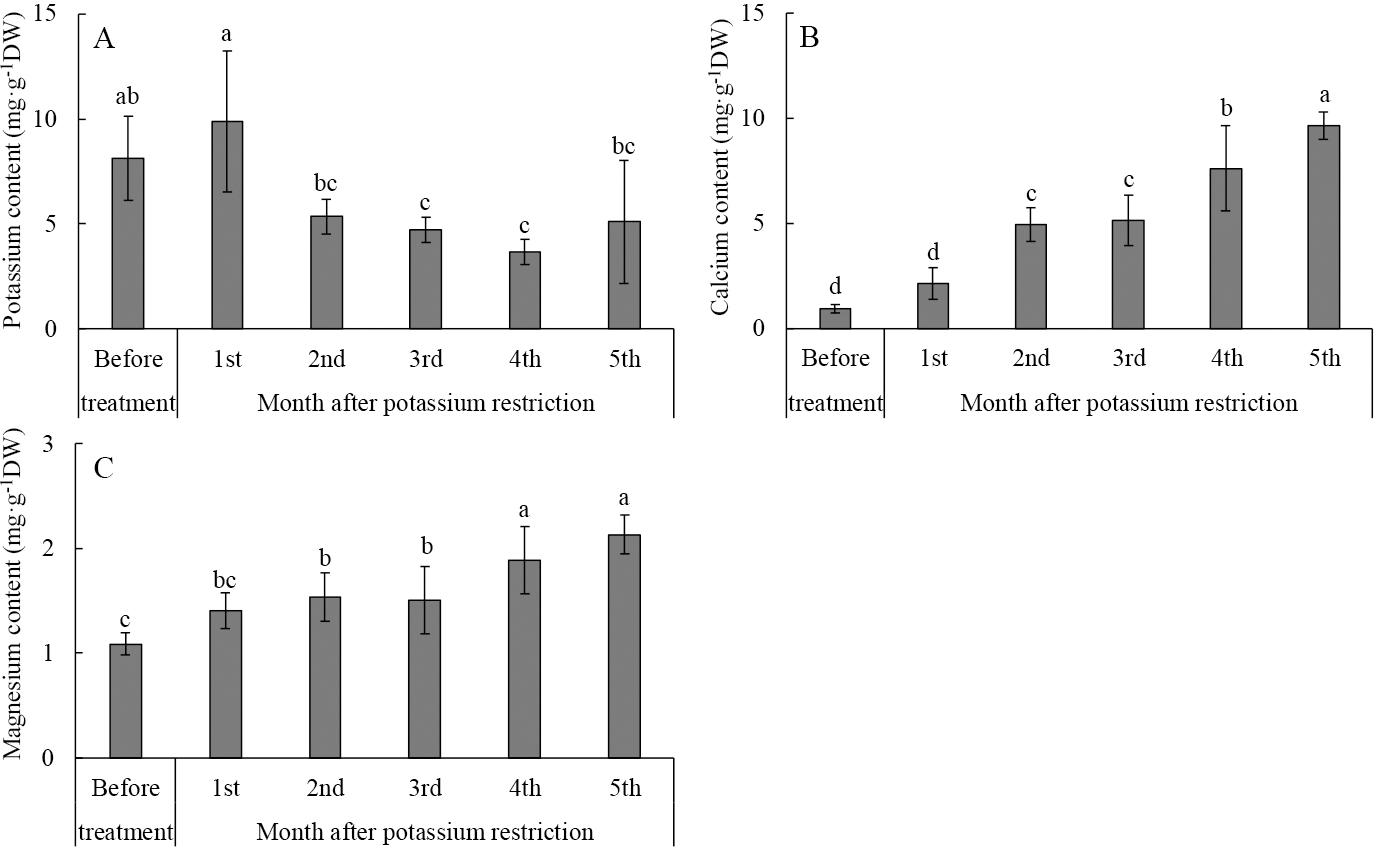
Effects of the long-term potassium restriction of blueberry trees potted with the urethane sponge-based medium on the monthly changes in the content of potassium (A), calcium (B), and magnesium (C) in new leaves in Experiment 3. Potassium restriction treatment lasted for five months. Different small letters denote a significant difference at P < 0.05 by Fisher’s LSD test (n = 4), and the vertical bars indicate SD.
Generally, blueberries are cultivated in an open field, but they can also be cultivated in pots (Higashide et al., 2006; Li and Bi, 2019; Clark and Zheng, 2020). On planting trees in an open field, it is not possible to quickly induce nutrient deficiency or stop fertilizer uptake due to the large amount of fertilizer retained in the soil, and the buffering effect of the soil. However, since Ikeura et al. (2012) considered that pot culture was more likely to facilitate fertilizer depletion than open field cultivation, limiting the amount of soil by pot culture and using fertigation as opposed to solid fertilizer might be a method to control the nutrient uptake. Therefore, in Experiment 1, in order to produce blueberry fruits with a low potassium content, trees in pots using peat moss as a medium were cultivated with fertigation, and the potassium restriction treatment was performed at different stages of growth. After five weeks of restricted potassium intake between the fruit coloring stage and harvesting stage, the fruit potassium content decreased by 35% compared with the control (Figs. 4 and 7). The fruit potassium content decreased by 53% compared with the control during the ten-week restriction from the flowering stage, and the tree potassium content decreased between the stages of flowering and fruit coloring, and then stabilized until the harvesting stage (Figs. 4 and 7). Therefore, it was suggested that the longer restriction resulted in a lowered potassium content approaching the 50% level. In previous studies of fruit vegetables that restricted potassium from the stages of flowering or fruiting, the reduction rates of the fruit potassium content were: 39% for melon (Asao et al., 2013), 55% for tomato (Ogawa et al., 2012), and 64% for strawberry (Mondal et al., 2017), which are in the same range as that of blueberry fruits. These results suggest the effectiveness of pot culture and fertigation with potassium-restricted nutrient solution in the production of low-potassium blueberry fruits.
Since the fruit potassium content halved in the ten-week potassium restriction in Experiment 1, the possibility of halving the fruit potassium content in the short-term was considered by employing a medium that can easily leach nutrients. Thus, the effectiveness of the urethane sponge-based medium with foamability and air permeability (ABOUT PAFCAL <http://www.suntory-midorie.com/en/about/about_pafcal/>, Accessed: December 28, 2020) was evaluated in Experiment 2. In the preliminary experiment, the EC of the drainage when nutrient solution was supplied was higher with the urethane sponge-based medium than with the peat moss medium (data not shown). That is, the urethane sponge-based medium had a lower nutrient retention capacity than the peat moss medium, and more nutrients were leached into drainage. As a result, in Experiment 2, the fruit potassium content with potassium restriction for approximately five weeks using the urethane sponge-based medium decreased by 48% compared with the control (Fig. 9). Therefore, it was suggested that this method is effective to produce low-potassium blueberry fruits.
Furthermore, in Experiment 3, we examined whether the fruit potassium content could be further reduced by long-term potassium restriction using the urethane sponge-based medium. Shortage of potassium uptake first reduces plant growth and causes visible symptoms of deficiency (Römheld and Kirkby, 2010), but the ten-week potassium restriction in Experiment 1 produced low-potassium blueberry fruits without a decrease in dry weight at the harvesting stage, along with the appearance of symptoms of potassium deficiency. In order to restrict more potassium for the long-term, we used blueberry trees with continuous flowering by inducing flower buds at low temperatures and short days, and then cultivating them in a greenhouse to continue flowering (Ogiwara et al., 2012). Using this cultivation method, potassium was restricted for five months, and no change in potassium content was noted between the second and fifth months (Fig. 12). However, symptoms of potassium deficiency such as leaf scorching and curling at the edges appeared in mature leaves, similar to those reported by Schilder et al. (2004) from the third month after the potassium restriction treatment (Fig. 11), which suggested a decrease in potassium content in blueberry trees, similar to other plant species with the appearance of symptoms of potassium deficiency in leaves (Pujos and Morard, 1997; Wind et al., 2004; Fernández-Escobar et al., 2016). Similar results were reported in prune (Prunus domestics) (Niederholzer et al., 1991). In tomato, the fruit potassium content decreased marginally by potassium limitation, while the leaf potassium content was markedly reduced (Kanai et al., 2007). The reason that the fruit potassium content did not decrease is likely due to potassium being necessary for growth (Ahmad and Maathuis, 2014), evidenced by the report that the concentration of potassium was highest in young developing tissues and reproductive organs (Römheld and Kirkby, 2010), and Pujos and Morard (1997) discussed the remobilization of potassium from aged towards younger tissues including fruits. However, the mechanism of potassium movement from leaves towards fruits in potassium-deficient plants was not clarified. Thus, further research should focus on the movement of potassium with gene expression, focusing on ion channels and transporters. Therefore, these results suggest that long-term potassium restriction was not effective for the production of low-potassium blueberry fruits.
It has been reported that potassium restriction increases the content of inorganic components such as calcium and magnesium in leaves (Ogawa et al., 2007, 2012; Mondal et al., 2017). In this study, potassium-restricted leaves had a decreased potassium content (Figs. 6, 10A, and 13A), with an increase in calcium but no change in magnesium (Figs. 8, 10B, C, and 13B, C). Bear and Prince (1945) showed that the total cation content remained constant as each nutrient supply varied, and Pujos and Morard (1997) suggested the antagonistic phenomena of potassium-magnesium and potassium-calcium according to the process of maintaining the sum of cations. Accordingly, competition of potassium with calcium rather than magnesium might have occurred in this study. However, since there have been studies showing that inorganic components such as sugars and amino acids increased in plants with low potassium (Itoh et al., 1997; Hermans et al., 2006), further investigation of the content of other osmotic substances is needed.
The effects of potassium deficiency on fruit weight (Ogawa et al., 2012; Asao et al., 2013) and sugar content (Kanai et al., 2007; Mondal et al., 2017; Shen et al., 2017) have also been investigated, but the effects differed depending on the plant species. Since there was no effect on mean fruit weight, soluble sugar content, or titratable acidity with potassium restriction shorter than ten weeks (Tables 1 and 2), it was considered that potassium restriction had little effect on the quality of blueberry fruits.
In conclusion, it was suggested that pot culture with fertigation was effective for producing low-potassium blueberry fruits. It was also shown that the fruit potassium content can be halved by short-term potassium restriction by employing a urethane sponge-based medium that can easily leach nutrients; however, the fruit potassium content did not decrease significantly after long-term potassium restriction. In addition, since fruit trees are grown for multiple years, plant damage caused by potassium limitation needs to be minimized to achieve sustainable production; the treatment may have adverse effects on flowering and vigor in the following years (Lyrene, 1992; Williamson and Miller, 2002; Bote and Jan, 2016). In future studies, we will investigate the recovery of low-potassium trees with the aim of producing low-potassium blueberry fruits over multiple years.